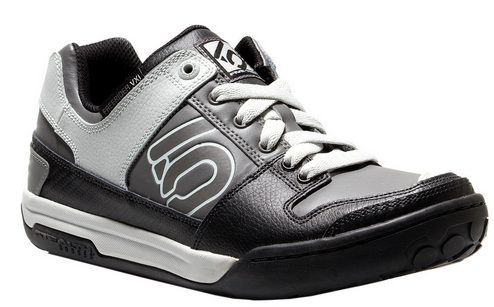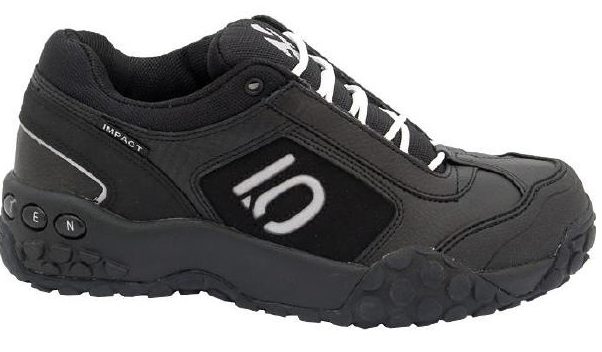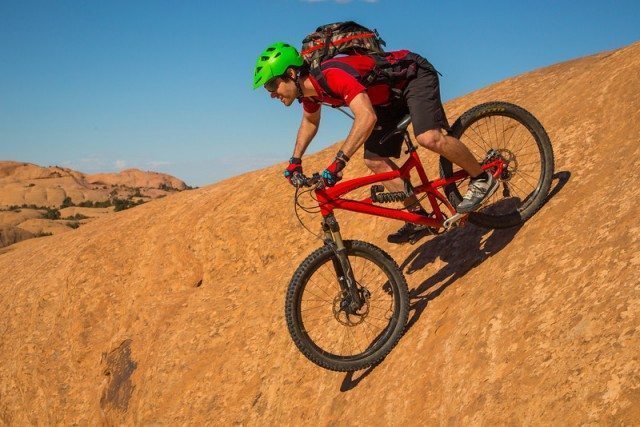
Five Ten Freerider VXi Elements
Intended Use: Cold, wet weather riding
Test Locations: Moab, Utah and Park City, UT
MSRP: $125
Days Ridden: 20
Tester Info: 5’ 8”, 160 lbs.
Five Ten has been producing flat-pedal riding shoes since the early 2000’s when they made them for Intense Cycles. The STEALTH rubber soles provided unprecedented grip on flat pedals since it used a compound with very little rebound energy.
Those STEALTH rubber soles on Five Ten’s Impact shoes quickly became popular with downhill racers and trail riders who preferred flat pedals over clipless ones. The shoes have now been around for years with only small changes. Then at the end of 2011, Adidas bought Five Ten. Enter the Freerider VXi and Freerider VXi Elements, two of the first shoes developed after the acquisition.
The Freerider VXi is designed for typical riding, while the Freerider VXi Elements is specifically geared toward wet, cold conditions.
Now, since I imagine most of you reading this review will have already ridden a Five Ten Impact or something similar, I’ll focus on the differences between that shoe and the new Freerider VXi Element.

Build
The Five Ten Freerider VXi Elements is very similar to the Freerider VXi, but there are a few key differences. The Five Ten Freerider VXi Elements has solid panels on the toe and sides of the shoe rather than mesh, a DWR treatment, PUR foam insulation, and Mi6 STEALTH rubber instead of S1 STEALTH. The side panels and DWR coating help keep water out of the shoe, the insulation keeps the shoe warm, and the Mi6 rubber is grippier, especially in wet conditions.
I’m really impressed with the build quality of the Freerider VXi Elements. I’ve noticed that the Impact’s sole and upper tended to separate, and there was wear on the inner ankle due to crank rub. These aren’t problems I’ve had with the new shoe.
The bonding between the sole and the upper appears to be better on the Freerider VXi Elements and there’s better protection on the ankle. Overall, the materials are more water resistant so the shoe dries out more quickly than the Impact did.

Sizing
First off, I should note that I have wide feet. The original Five Ten Impact was a wide shoe and fit me perfectly in a size 9. The last of the Freerider VXi and Freerider VXi Elements is slightly narrower and longer than that of the Impact.
I found that the size 8.5 in the Freerider VXi Elements fits better then the size 9, but width-wise, it’s slightly less comfortable. Those with narrow feet will be excited about the change, and those of us with wide feet need not be too disappointed. There’s enough give in the shoe and the last is wide enough to still fit fine. But because of this sizing change, I’d definitely recommend trying before you buy.
The Ride
The Element is the first bike shoe to use Mi6 rubber. This rubber is decidedly grippier than the S1 stealth rubber of the Freerider VXi and the Impacts, and even though it wears slightly more quickly, it’s noticeably better in wet, cold conditions. The different compound compensates for the loss in traction you normally experience in lower temperatures (think winter versus summer tires for your car).
I found I could reposition my foot easier in the standard Freerider VXi than in the Impact, which has dot soles, but it wasn’t quite as grippy and it was much more difficult to hike in.

The Freerider VXi Elements combines Mi6 rubber, a smooth sole under your midfoot, and small dots under your toe and heel. The new rubber makes the shoe’s smooth sole about as grippy as the dot sole of the Impact, so it too can be hard to reposition and it doesn’t work well for hiking. Even though the sole has enough dots at the toe to help with this, I still reach for my old Impacts when I know a ride is going to involve walking.

Compared to the Impact, the Elements sole is stiff and thin, which means pedal-feel is improved. And by limiting the wrap-around tread, the shoe feels much less clunky.
The VXi Elements has less padding, which means less protection, but it also means the shoe doesn’t absorb as much water. The shoes can dry out in a few hours, rather than the full day the Impact needed. The VXi Elements keeps water out if you step in a puddle or splash through one while riding. The solid panels also block the wind, although this does make the shoe less breathable.
If temperatures were below 40 degrees, I much preferred this shoe to the standard VXi. Above 60 degrees, and I would grab the standard VXi. I found that between 40 and 60 degrees, either shoe worked well.
Durability
As I mentioned above, the Mi6 seems to wear just slightly quicker than the S1. That said, I anticipate I can get at least another 60 days out of the Freerider VXi Elements before general wear and tear starts to affect its performance.
Bottom Line
This is a really good shoe. Combined with Kona Wah-Wahs, Xpedo Sprys, and Echo SL Pedals, I found the grip to be reliable and strong both in dry and wet conditions. The Freerider VXi Elements is lighter and more comfortable than the Impact, and I much prefer it to my duct-taped VXi for riding in cold or wet conditions.
I’ll be buying another pair of the Elements when they wear out.
